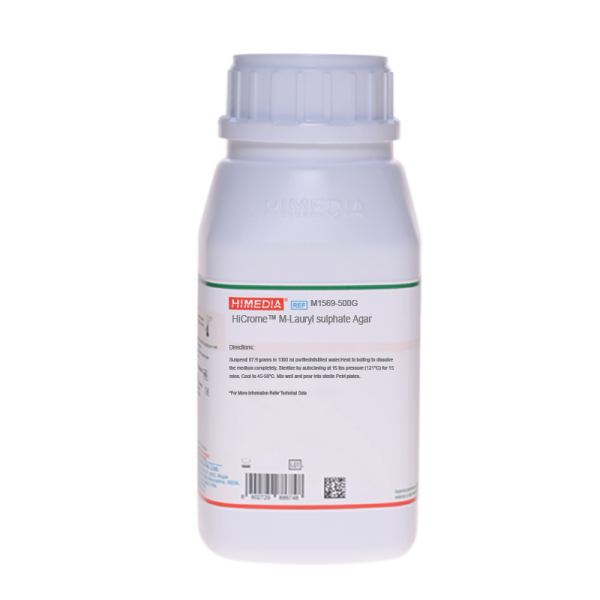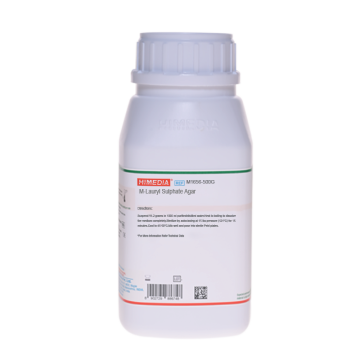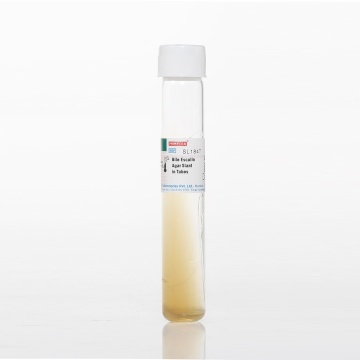 Your enquiry has been submitted
Your enquiry has been submitted
HiCrome™ Membrane Lauryl Sulphate Agar
Intended Use
Recommended for the differentiation and enumeration of Escherichia coli and other coliforms by a single membrane filtration technique.
Composition**
| Ingredients | g / L |
|---|---|
| Peptone | 40.000 |
| Yeast extract | 6.000 |
| Lactose | 30.000 |
| Phenol red | 0.200 |
| Sodium lauryl sulphate (SLS) | 1.000 |
| Sodium puruvate | 0.500 |
| Chromogen | 0.200 |
| Agar | 10.000 |
Final pH (at 25°C): 7.4±0.2
**Formula adjusted, standardized to suit performance parameters
Directions
Suspend 87.9 grams in 1000 ml purified/distilled water. Heat to boiling to dissolve the medium completely. Sterilize by autoclaving at 15 lbs pressure (121°C) for 15 mins. Cool to 45-50°C. Mix well and pour into sterile Petri plates.
Principle And Interpretation
HiCrome™ M-Lauryl sulphate Agar is a modification of the Lauryl Tryptose Broth, formulated by Mallman and Darby (1). This chromogenic medium is recommended for the presumptive identification and differentiation of Escherichia coli and other coliforms by a single membrane filtration technique (2,3). The incorporation of chromogen X-glucuronide and the dye phenol red favours the differentiation of E. coli and other coliforms on the basis of colour. It can also be used to isolate E.coli from water samples.
Peptone and yeast extract provide carbon, nitrogen compounds, long chain amino acids, vitamins and other essential growth nutrients to the organisms. Lactose acts as a source of fermentable sugar while sodium lauryl sulphate inhibits organisms other than coliforms. The enzyme ß-D-glucuronidase produced by E.coli, cleaves X-glucuronide, imparting a green colour to the colonies. Lactose fermentation is detected by phenol red indicator.
Type of specimen
Water samples
Specimen Collection and Handling
For water samples, follow appropriate techniques for sample collection, processing as per guidelines and local standards (3). After use, contaminated materials must be sterilized by autoclaving before discarding.
Warning and Precautions
Read the label before opening the container. Wear protective gloves/protective clothing/eye protection/face protection. Follow good microbiological lab practices while handling specimens and culture. Standard precautions as per established guidelines should be followed while handling specimens. Safety guidelines may be referred in individual safety data sheets.
Limitations
- ß-glucuronidase is present in 97% of E.coli strains, however few E.coli may be negative.
- Some species may show poor growth due to nutritional variations.
- Further biochemical and serological test are necessary for confirmation.
Performance and Evaluation
Performance of the medium is expected when used as per the direction on the label within the expiry period when stored at recommended temperature.
Quality Control
Appearance: Light yellow to pink homogeneous free flowing powder
Gelling: Firm, comparable with 1.0% Agar gel.
Colour and Clarity of Prepared medium: Red coloured, clear to slightly opalescent gel forms in Petri plates
Reaction: Reaction of 8.8% w/v aqueous solution at 25°C. pH : 7.4±0.2
pH: 7.20-7.60
Cultural Response: Cultural characteristics observed after an incubation at 35-37°C for 18-24 hours.
| Organism | Inoculum (CFU) | Growth | Colour of Colony |
|---|---|---|---|
| Escherichia coli ATCC 25922 (00013*) | 50-100 | luxuriant | green |
| Klebsiella pneumoniae ATCC 13883 (00097*) | 50-100 | good | yellow, mucoid |
| Staphylococcus aureus subsp aureus ATCC 25923 (00034*) | >=104 | inhibited | - |
| Salmonella Enteritidis ATCC 13076 (00030*) | 50-100 | good | pink |
Key : *Corresponding WDCM numbers.
Storage and Shelf Life
Store between 15-25°C in a tightly closed container and the prepared medium at 2-8°C. Use before expiry date on the label. On opening, product should be properly stored dry, after tightly capping the bottle in order to prevent lump formation due to the hygroscopic nature of the product. Improper storage of the product may lead to lump formation. Store in dry ventilated area protected from extremes of temperature and sources of ignition Seal the container tightly after use. Product performance is best if used within stated expiry period.
Disposal
User must ensure safe disposal by autoclaving and/or incineration of used or unusable preparations of this product. Follow established laboratory procedures in disposing of infectious materials and material that comes into contact with sample must be decontaminated and disposed of in accordance with current laboratory techniques (4,5).
Reference
- Mallman and Darby, 1941, Am.J. Public Health, 31:127.
- Sartory D.P. and Howard L, 1992, Lett Appl. Microbiol. 15:273-276. Methods for Examination of Waters and Associated Materials, Environment Agency, 1998, Standing Committee of Analysts.
- Lipps WC, Braun-Howland EB, Baxter TE,eds. Standard methods for the Examination of Water and Wastewater, 24th ed. Washington DC:APHA Press; 2023.
- Isenberg, H.D. Clinical Microbiology Procedures Handbook. 2nd Edition.
- Jorgensen,J.H., Pfaller , M.A., Carroll, K.C., Funke, G., Landry, M.L., Richter, S.S and Warnock., D.W. (2015) Manual of Clinical Microbiology, 11th Edition. Vol. 1.
| Product Name | HiCrome™ Membrane Lauryl Sulphate Agar |
|---|---|
| SKU | M1569 |
| Product Type | HiCrome™ |
| Physical Form | Powder |
| Origin | Animal |
| Packaging type | HDPE |
| References | 1.Mallman and Darby, 1941, Am.J. Public Health, 31:127.2.Sartory D.P. and Howard L, 1992, Lett Appl. Microbiol. 15:273-276.3.Methods for Examination of Waters and Associated Materials, Environment Agency, 1998, Standing Committee of Analysts.4.Baird R.B., Eaton A.D., and Rice E.W., (Eds.), 2015, Standard Methods for the Examination of Water and Wastewater,23rd ed., APHA, Washington, D.C. 5.Isenberg, H.D. Clinical Microbiology Procedures Handbook. 2nd Edition. 6.Jorgensen,J.H., Pfaller , M.A., Carroll, K.C., Funke, G., Landry, M.L., Richter, S.S and Warnock., D.W. (2501)Manual of Clinical Microbiology, 11th Edition. Vol. 1. |
| Customized Product Available | No |








